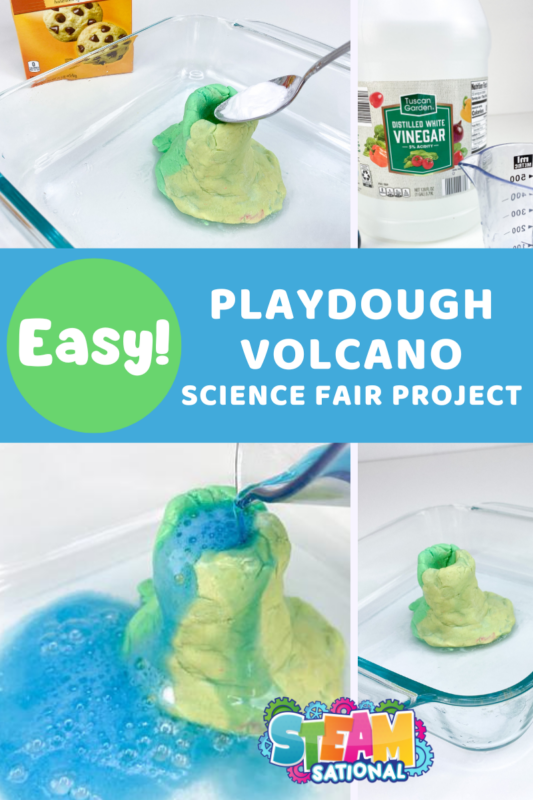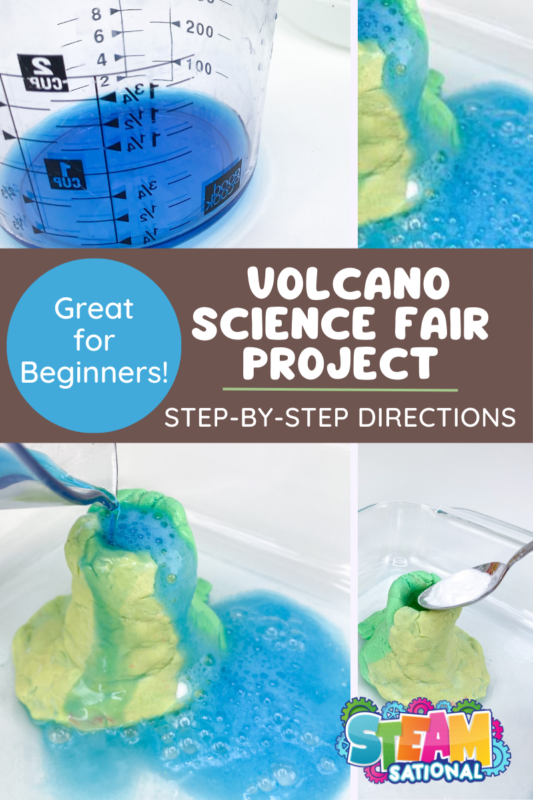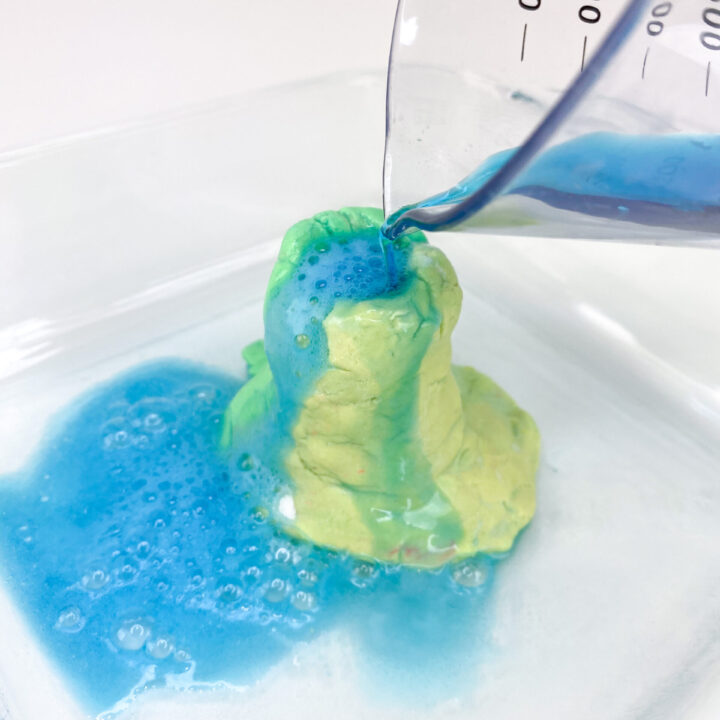Learn about the science behind volcanic eruptions and lava flows while you learn how to build a volcano out of playdough. Conduct a series of tests on your playdough volcano and use it to explain the properties of different materials, how a play doh volcano works, and how to create a display board volcano science fair project hypothesis to use for your volcano science project.
This simple and classic volcano science experiment will help you create your very own volcanic landscape and create the best volcano science fair project display board at the science fair!

Easiest science fair ever! With our tips, the classic baking soda and vinegar playdough volcano experiment will be the talk of the science fair!
The Easiest Science Fair Project- Playdough Volcano
Have you ever wondered how volcanoes erupt and what causes lava flows? Get ready to create your very own volcanic landscape and learn about the properties of different materials, earth science, and a whole lot more!
The play doh volcano is a classic science fair project for a reason, but with our added tips and tricks, your volcano science fair project will be the best one ever.
How Does a Volcano Work?
Volcanic eruptions occur when magma rises to the surface of the earth through a volcano’s vent. Magma is molten rock that is located beneath the earth’s surface and is composed of various minerals, gases, and fluids.
When magma rises, it can encounter different obstacles along the way, such as solid rock or water. When it encounters these obstacles, pressure builds up within the magma chamber.
This pressure causes the magma to become more buoyant and eventually burst through the surface, resulting in an eruption.
The type of eruption that occurs is determined by the type of magma and the amount of gas that is present.
If the magma is runny and has low levels of gas, it will likely result in a more gentle, effusive eruption. If the magma is thick and has high levels of gas, it can result in a more explosive eruption.
Understanding the science behind volcanic eruptions is essential when deciding on a hypothesis for your science fair project.
With this knowledge, you can create a hypothesis that is both feasible and scientifically sound.
What You Need for a Playdough Volcano Science Fair Project
In order to conduct a successful experiment about playdough volcanoes, you will need a few specific materials.
The type of playdough you choose can affect the consistency of the lava flow. So, if you want to test the impact of the playdough on your experiment, consider using different brands or types of playdough.
Additionally, if you want to measure the height of the eruption, you may want to consider using a ruler or measuring tape.
- Playdough
- Air dry clay
- Non-drying clay
- Polymer clay
- Art tray
- Safety goggles
- Food coloring
- Baking soda
- Vinegar (and other types of acid safe to handle, like lemon juice)
- Dish soap
- Measuring tape
- Measuring cups and spoons
- Science fair notebook
- Science fair project planner
- Camera for recording results
Science Fair Project Requirements
Most science fairs require similar things to compete in a science fair. There will always be variations, so always follow the specific guidelines set by your science fair.
But most science fair projects will need the following sections in your final report:
Research
Before starting your playdough volcano science fair project, take time to learn about how volcanoes work. Volcanoes are fascinating in how they work, and even modern scientists can’t fully explain everything about how volcanoes work.
Research volcanoes, and then create a question that you think you can prove or disprove with your play doh volcano.
Here is a video about the science of volcanoes to begin your research:
Formulate a Hypothesis
To create a successful science fair project about volcanoes, it’s important to have a strong hypothesis. Your hypothesis should be based on a clear understanding of the science behind how volcanoes erupt.
For example, you might hypothesize that adding baking soda to the vinegar and playdough mixture will increase the height of the eruption. Or you might hypothesize that changing the type of playdough used will affect the thickness of the lava flow.
Whatever your hypothesis, make sure it is grounded in scientific principles and can be tested through experimentation.
Data Collection
Gather information about the chosen volcano and its eruption. Look at pictures, videos, and other visuals related to the eruption.
Use the gathered information to create a hypothesis about the eruption.
Experiment
Set up an experiment to test the hypothesis. The experiment should be designed to accurately observe the conditions that you want to test to learn more about your question about volcanoes.
Carry out the experiment and take precise measurements or record video and other visual evidence.

Organize and Analyze Data
Analyze the data collected from the experiment and determine the accuracy of the hypothesis.
Take note of the differences in consistency and color of the lava flow depending on the type of Playdough used.
Did certain colors create a more vibrant lava display? Did softer or harder Playdough affect the flow of the lava in any way?
These observations will help you draw conclusions about the experiment and make for a stronger science fair project.
Write a Data Summary
Compile a report or presentation that summarizes the findings and discusses the implications of the playdough volcano experiment and its results.
Once you have recorded and analyzed your results, it’s time to create your playdough volcano display board for the science fair.
More Science Fair Project Ideas
If you’re looking for a science fair project that will impress judges and classmates alike, consider experimenting with some of these other fun science fair project ideas!
- Science Fair Planner Project Planner
- 15 Easy, Frustration-Free Elementary School Science Fair Projects
- 30+ Classic Science Fair Projects for Elementary School
- 30 Science Fair Ideas that Wow
How to Set Up a Volcano Science Fair Project Display Board
There are many ways to set up a volcano science fair project display board, but here is an example to get you started!
Modify each section as required to follow the rules for your specific science fair and the variables and hypothesis of your own project.
If you need help, check out the STEAMsational Science Fair Project Planning Checklist below!
Section 1: Introduction
Introduce your project, why you chose to make a playdough volcano and the question that inspired your hypothesis.
Section 2: Hypothesis
Write your hypothesis and be prepared to explain why you chose it.
Section 3: Playdough Volcano Science
Explain the scientific concept that you wanted to test to prove or disprove your hypothesis.
Section 4: Experiment
Explain how you set up your playdough volcano experiment and what variables you tested along with other details about your project.
Section 5: Results
Summarize the results of each variable test. Was your hypothesis proven or disproven? Discuss what other testing may be required to fully answer your question about volcanoes.
How to Make a Volcano with Playdough- Step-by-Step Instructions for the Science Fair
Follow along with these directions to make your own playdough volcano science fair project!

How to Make a Volcano with Playdough
Get ready to learn about earth science and create a spectacular playdough volcano science fair project display board for your science fair! We’ve got all the tips and tricks to make sure that your playdough volcano project is the best ever. Try it today!
Materials
- Different types of play dough (non-hardening clay, air dry clay, polymer baking clay, play doh, etc)
- Vinegar and other types of acid
- Baking soda
- Food coloring
- Dish soap
Tools
- Clay shaping tools
- Measuring cups and spoons
- Art tray
- Safety goggles
- Science project journal
- Science project planner
- Measuring tape
Instructions
1. Create a volcano using play dough.
2. Set your volcano in a pan to contain the “lava.”
3. Add a spoonful of baking soda to your volcano along with a few drops of dish soap.
4. Mix about one-half cup of vinegar with 3 drops of food coloring.
5. Pour the vinegar into your volcano and watch it erupt!
6. Record the data to prove or disprove your hypothesis.
7. Change your chosen variables and run the experiment again.
8. Once all variables have been tested, create a full data report to use in your volcano science fair project display.
Recommended Products
As an Amazon Associate and member of other affiliate programs, I earn from qualifying purchases.
-
 Tape Measure
Tape Measure -
 Liquid Food Coloring
Liquid Food Coloring -
 Liquid Dish Soap
Liquid Dish Soap -
 Instant Camera
Instant Camera -
 Safety Goggles
Safety Goggles -
 Science Fair Journal
Science Fair Journal -
 Air Dry Clay
Air Dry Clay -
 Polymer Clay for Baking
Polymer Clay for Baking -
 Play-Doh
Play-Doh -
 Science Fair Project Planner
Science Fair Project Planner -
 Letter Stencils
Letter Stencils -
 Display Board Making Kit
Display Board Making Kit -
 Poster Board Letters
Poster Board Letters -
 Presentation Board Kit
Presentation Board Kit -
 Permanent Markers
Permanent Markers -
 Poster Board
Poster Board -
 Scissors
Scissors -
 Foam Mounting Tape
Foam Mounting Tape -
 Science Board Stickers
Science Board Stickers -
 Science Presentation Board Project Kit
Science Presentation Board Project Kit -
 Science Fair Project Titles
Science Fair Project Titles -
 Art Trays
Art Trays -
 Vinegar
Vinegar -
 Measuring Cups and Spoons
Measuring Cups and Spoons -
 Baking Soda
Baking Soda -
 Non-Hardening Clay
Non-Hardening Clay

